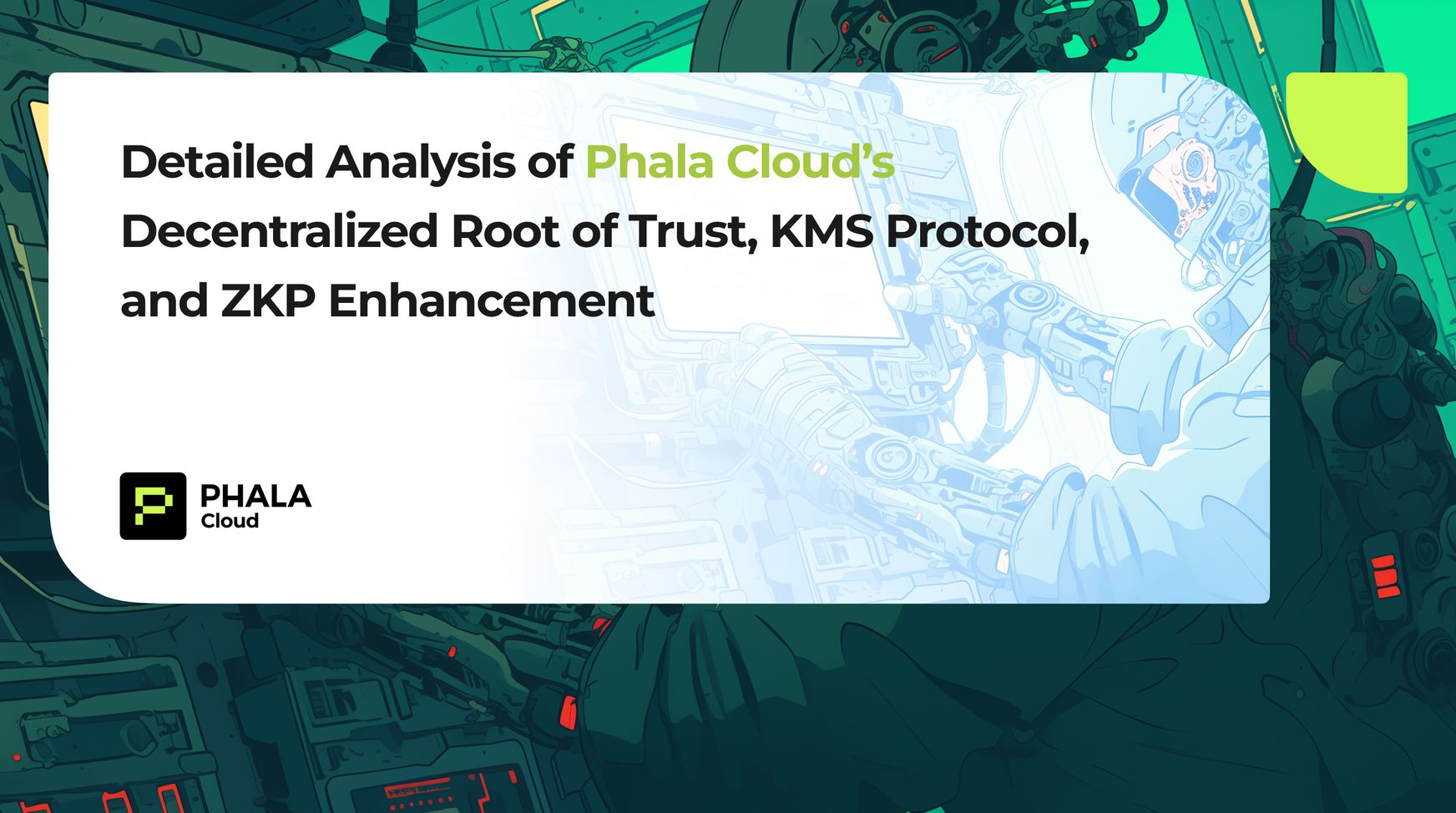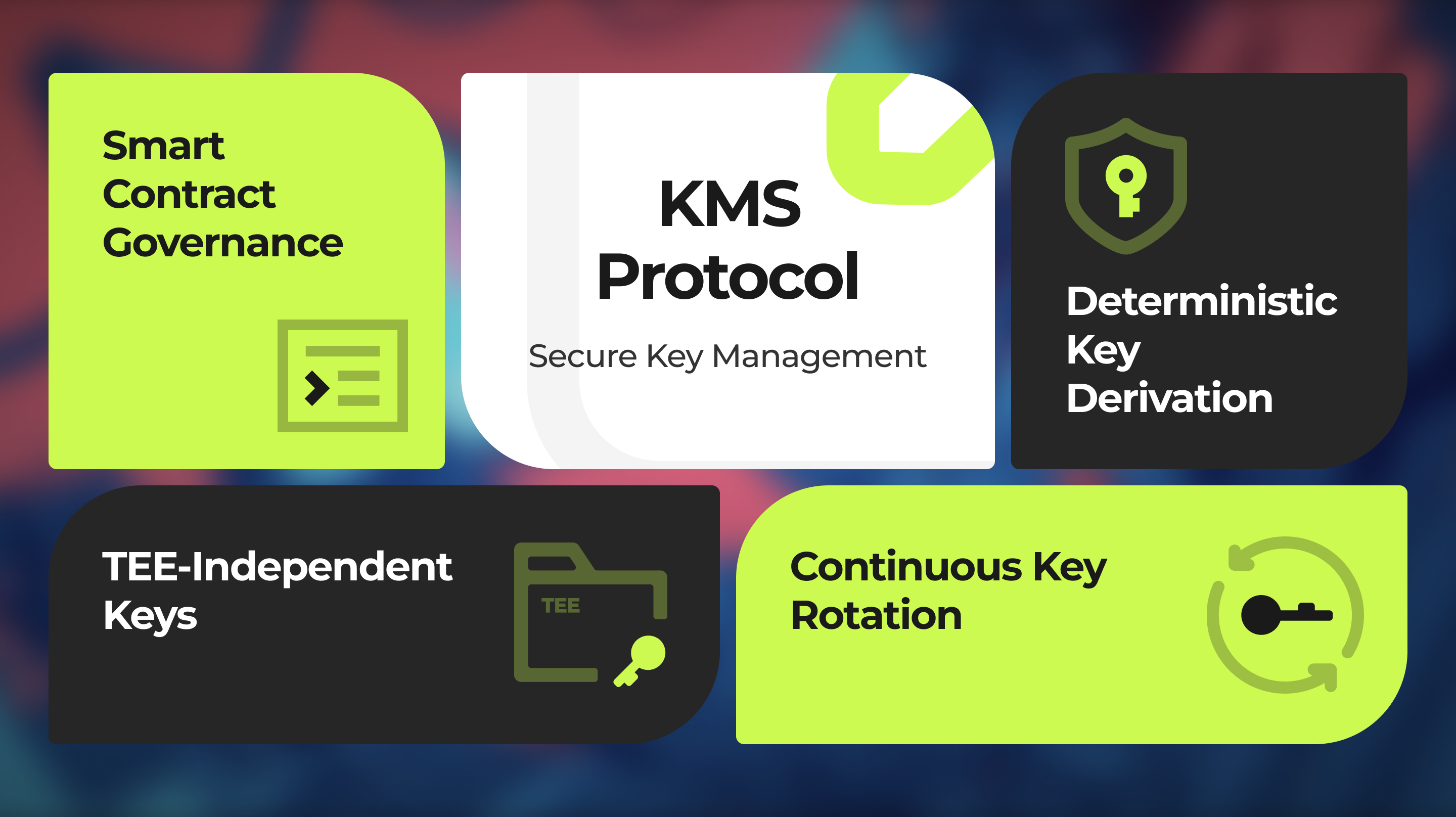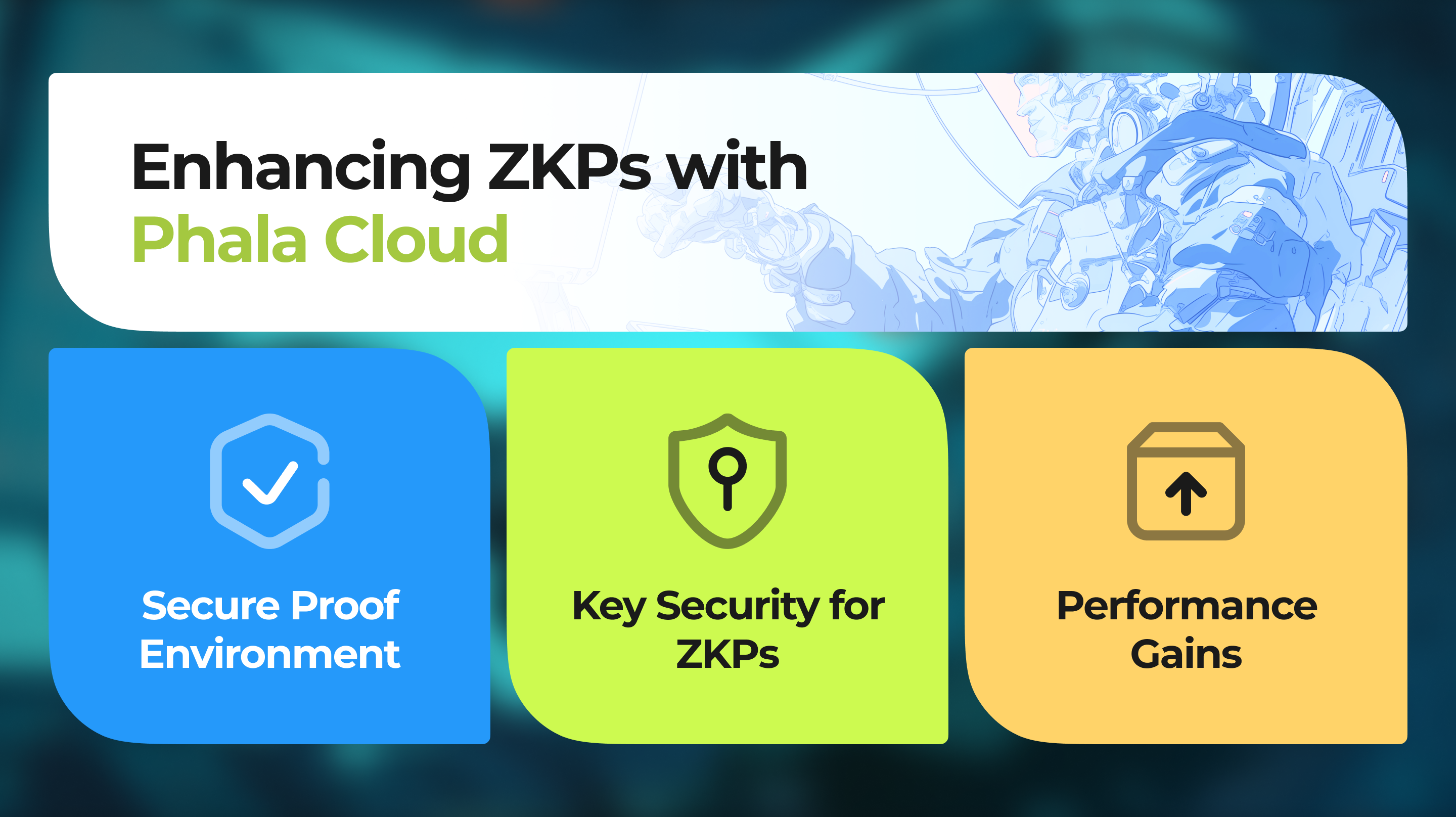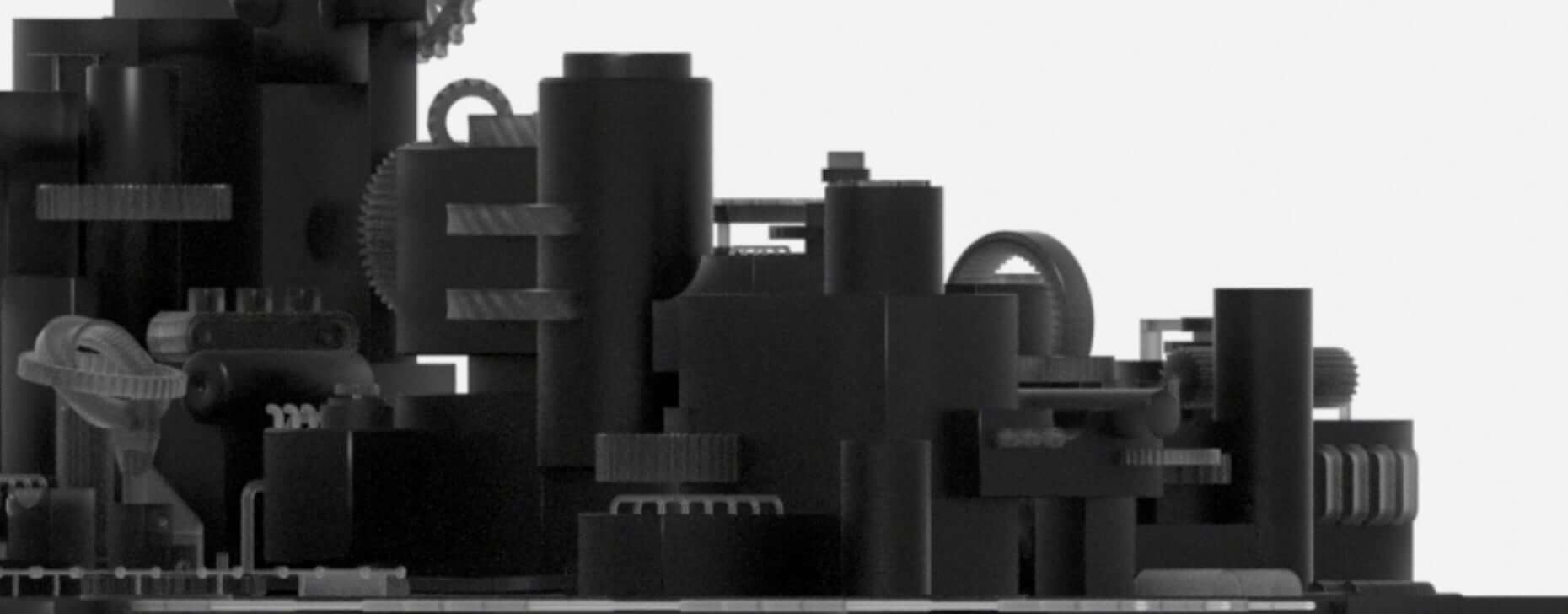
Detailed Analysis of Phala Cloud’s Decentralized Root of Trust, KMS Protocol, and ZKP Enhancement
2025-04-04
Introduction: The Need for Secure and Private Computation
As a developer working on blockchain applications, you’re likely exploring ways to ensure privacy and security without sacrificing performance. Trusted Execution Environments (TEEs) and Zero-Knowledge Proofs (ZKPs) are two powerful tools for privacy-preserving computation, each with distinct strengths.
But here’s the thing—you don’t have to choose between them. TEEs and ZKPs can work together, and Phala Cloud, a TEE-based platform, makes this combination practical with its decentralized root of trust and Key Management System (KMS) protocol.
In this post, we’ll dive deep into TEEs and ZKPs, explore how they complement each other, and show how Phala Cloud’s unique tech stack enhances ZKPs for your projects—especially for compute-intensive workloads like AI and machine learning. With detailed tables and real usage stats, you’ll see why this matters for your next build.
TEE and ZKP: What They Bring to the Table
Let’s break down these technologies in the context of privacy-preserving computation.
- TEE: A TEE is a hardware-isolated environment—like Intel SGX, AMD SEV, or NVIDIA H100/H200 GPUs—where your code and data run shielded from the rest of the system, including the OS and hypervisor. It uses memory encryption and secure enclaves to ensure confidentiality and integrity, making it fast and efficient for secure computation.
- ZKP: ZKP is a cryptographic method that lets you prove a statement—like a transaction’s validity—without revealing the data. Think ZK-SNARKs or ZK-STARKs, used in zk-Rollups or privacy coins like Zcash. ZKPs are mathematically secure but can be slow due to the heavy compute load of proof generation.
Here’s a detailed comparison:
| Metric | ZKP | TEE |
| Privacy Mechanism | Cryptographic proofs | Hardware isolation |
| Data Confidentiality | Strong | Strong |
| Computational Overhead | High (proof generation) | Low (direct execution) |
| Verification Speed | Fast (succinct proofs) | Fast (on-chain RA report) |
| Scalability | High (off-chain scaling) | Moderate (hardware-dependent) |
| Trust Model | Mathematical (setup risks) | Hardware + Software (vendor trust) |
| Attack Resistance | Strong (mathematical) | Moderate (side-channel risks) |
| Implementation Effort | Complex (circuit design) | Moderate (enclave setup) |
| Use Case Fit | Specific (proof-based privacy) | Broad (general computation) |
This table shows their differences: ZKPs are great for scalable, proof-based privacy but demand significant compute resources. TEEs excel in speed and versatility, though they rely on hardware trust and can be vulnerable to side-channel attacks.
How TEEs Enhance ZKPs
TEEs and ZKPs aren’t competitors—they’re allies. TEEs can bolster ZKPs in several practical ways:
- Secure Proof Generation: ZKP proof generation needs a trustworthy environment to avoid tampering. TEEs provide a hardware-isolated space to run this process, ensuring the proof’s integrity. For example, you can generate a ZK-SNARK proof inside a TEE to verify a private transaction, knowing the computation is safe from interference.
- Setup Protection: Many ZKPs, like ZK-SNARKs, require a trusted setup—a potential weak point if compromised. A TEE can isolate this setup, reducing risks by keeping it away from external access.
- Performance Boost: ZKP proof generation can be a bottleneck. TEEs can offload heavy computations—like pre-processing data for a ZK proof—making the process faster. This is especially useful for zk-Rollups, where off-chain computation needs to be both secure and efficient.
Here’s how they work together:
| Collaboration Area | How TEE Helps ZKP | Outcome | Developer Benefit |
| Proof Generation | Runs in a secure enclave | Prevents tampering | Reliable ZK proofs |
| Setup Security | Isolates trusted setup | Reduces setup vulnerabilities | Safer ZKP deployment |
| Computation Efficiency | Offloads heavy tasks | Speeds up ZKP workflows | Faster privacy-preserving apps |
This synergy lets you use ZKP’s cryptographic privacy while leveraging TEE’s secure environment for computation, giving you a balanced approach for your app.
Phala Cloud: TEE-Powered Privacy with a Twist
Phala Cloud, built on Phala Network’s blockchain, takes this TEE-ZKP partnership to the next level with its unique tech stack. It’s designed for developers who need privacy and security without a steep learning curve, and it’s particularly strong for compute-intensive workloads like AI and machine learning.
Decentralized Root of Trust: A Game-Changer
Traditional TEE providers—like those using Intel SGX or AMD SEV—rely on a single hardware vendor as the root of trust. If that vendor’s hardware has a flaw or is compromised, the whole system is at risk. Phala Cloud flips this model with a decentralized root of trust, as outlined in the Phala docs.

Here’s how it works:
- Distributed Trust: Trust is spread across a network of TEE-enabled nodes, not tied to one vendor. Blockchain consensus ensures only secure nodes participate, verified through remote attestation reports.
- No Single Point of Failure: If one node or hardware vendor is compromised, the network’s consensus keeps the system secure, unlike centralized TEEs where a single flaw can bring everything down.
- Enhanced Security for ZKPs: When generating ZK proofs, this decentralized trust ensures the TEE environment is reliable, as multiple nodes validate its integrity. This is a big win for apps needing high trust, like private blockchain transactions.
This approach makes Phala Cloud more resilient than traditional TEE providers, giving you confidence that your app’s security isn’t pinned to one weak link.
KMS Protocol: Secure Key Management
Phala Cloud’s Key Management System (KMS) protocol, detailed in the Phala docs, manages cryptographic keys in a decentralized way, which is crucial for ZKP workflows.

Here’s the breakdown:
- Smart Contract Governance: Keys are managed via smart contracts on the Phala Network blockchain, not a single server, reducing the risk of key compromise.
- Deterministic Key Derivation: Keys are generated deterministically based on inputs, so they can be regenerated if needed, ensuring recoverability without sacrificing security.
- TEE-Independent Keys: Keys aren’t tied to specific TEE hardware, so your app can migrate between nodes without data loss or security issues.
- Continuous Key Rotation: Keys are rotated regularly to prevent long-term exposure, adding an extra layer of protection.
For ZKPs, this means the keys used in proof generation or verification are managed securely. If a TEE node fails, the KMS ensures keys remain safe, and the system can recover without compromising your app’s privacy.
Enhancing ZKPs with Phala Cloud

Phala Cloud’s TEEs, decentralized root of trust, and KMS protocol directly enhance ZKPs:
- Secure Proof Environment: The decentralized root of trust ensures the TEE where ZK proofs are generated is trustworthy, as multiple nodes verify its integrity. This is safer than traditional TEEs, where a single vendor flaw could undermine the proof.
- Key Security for ZKPs: The KMS protocol manages ZKP keys in a decentralized way, ensuring they’re not a single point of failure. This is critical for ZKPs, where key compromise could invalidate proofs.
- Performance Gains: TEEs in Phala Cloud, especially with GPU support, can handle ZKP’s heavy computations—like proof generation—more efficiently, reducing latency compared to running ZKPs alone.
A recent benchmark study on Phala Cloud demonstrates this capability in action. The study tested SP1 zkVM—a zero-knowledge virtual machine from Succinct Labs—running on NVIDIA H200 GPUs in a TEE environment. The results are compelling: the TEE overhead stayed below 20% for complex workloads like zkEVMs, ZK-TLS, zkRollups, and zkMLs, with plenty of room to scale. The setup used 1 NVIDIA H200 NVL GPU (141GB memory, 4.8TB/s bandwidth) alongside an Intel Xeon 8558 CPU with 96 cores, all managed by Phala’s dstack SDK with zero code changes required. The overhead primarily came from memory encryption, but for long-running tasks, this fixed cost became minimal, making it ideal for compute-intensive ZKP applications. This benchmark shows that with GPU TEE support, you can deploy demanding workloads—like LLM inference, ZK provers, or ML-based apps—on Phala Cloud, combining ZKP’s privacy with TEE’s performance.
Here’s how these features stack up:
| Feature | Phala Cloud (Decentralized TEE) | Traditional TEE | ZKP Enhancement |
| Trust Model | Decentralized, blockchain-verified | Centralized (vendor-based) | Secures proof generation |
| Key Management | Decentralized, smart contract-based | Often centralized | Protects ZKP keys |
| Failure Resilience | High (distributed nodes) | Low (single vendor risk) | Reduces ZKP setup risks |
| Performance | High (GPU TEEs, <20% overhead) | Moderate (CPU-based) | Speeds up ZKP computation |
AI Use Cases with Privacy
Phala Cloud is built for AI, with GPU TEEs like NVIDIA H100/H200. The Phala blog highlights use cases like confidential ML training—training a model on private healthcare data without leaks—or autonomous AI agents, like a chatbot handling sensitive queries. You can generate a ZK proof in a TEE to verify the model’s accuracy without exposing the data, all secured by Phala’s decentralized trust and KMS.
| AI Use Case | Phala Cloud Role | Developer Takeaway |
| Private ML Training | Secures data in TEE, proves with ZKP | Train models without leaks |
| AI Agents | Runs logic in TEE, verifies with ZKP | Build secure, private tools |
Research Benchmark Study: GPU TEE in zkVMs
If you’re working with zero-knowledge virtual machines (zkVMs) or exploring secure computing, you’ve likely run into the trade-off between performance and privacy. Our latest benchmark study at Phala Network funded by Succinct tackles that head-on, testing SP1 zkVM on NVIDIA H200 GPUs in a Trusted Execution Environment (TEE).
When evaluating the practicality of this approach, cost is an important factor. While the H200 represents the high-end of NVIDIA's GPU offerings, the cost-performance ratio remains favorable for many use cases:
| GPU Model | Memory | Bandwidth | Compute (INT8) | Hourly Cost |
| H200 NVL | 141GB | 4.8TB/s | 3341 TFLOPS | $2.5 |
| L4 (AWS G6) | 24GB | 300GB/s | 485 TFLOPS | $0.805 |
H200 offers approximately 6x the compute power and nearly 6x the memory of the L4, at roughly 3x the cost, making it a cost-effective choice for memory-intensive and computationally demanding zkVM workloads. For many applications, the performance benefits and additional security guarantees justify the increased cost.
Why This Matters for Developers
We’ve learnt that TEE strengthens and compliments ZKP. Phala Cloud makes this real with a secure, flexible platform backed by real usage.
What do you get?
- Security: TEEs and decentralized trust keep your app locked down.
- Flexibility: Deploy with Docker, mix in MPC or ZK as needed.
- AI Power: GPU TEEs handle confidential AI workloads.
- Proof: 1,000 teams who have deployed 2,600+ vCPU’s and counting.
For Web3 developers, Phala Cloud is your foundation for building apps that last. Ready to start?
- Check the Phala Cloud Docs.
- Explore live projects on the Explorer.
Wrapping Up
For developers, TEEs and ZKPs aren’t an either/or choice—they’re a powerful combo for privacy-preserving computation. Phala Cloud’s decentralized root of trust and KMS protocol make it a standout TEE platform, enhancing ZKPs with secure proof generation, robust key management, and high performance.
Deploy something at Phala Cloud and explore how this tech can level up your work.
